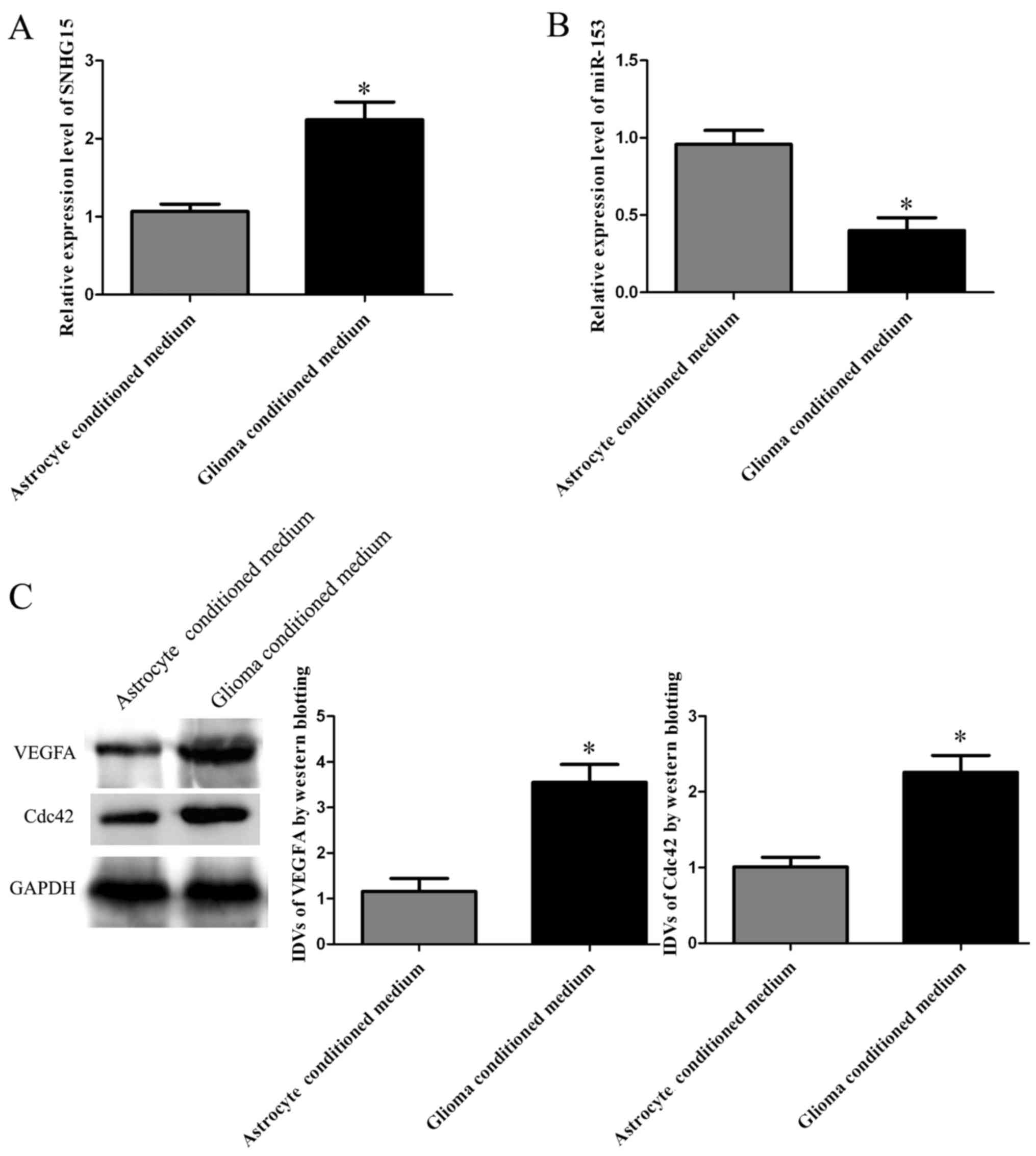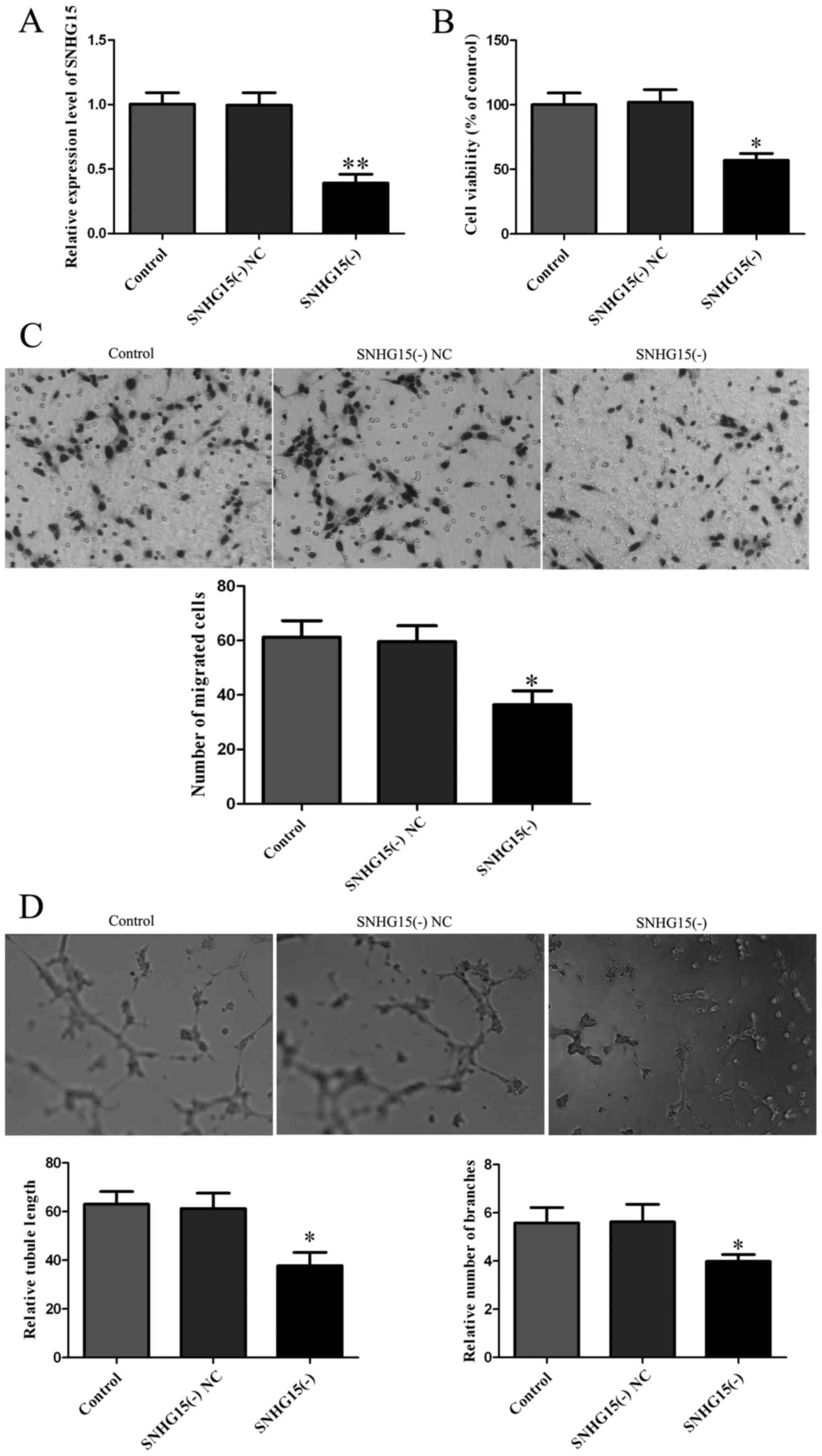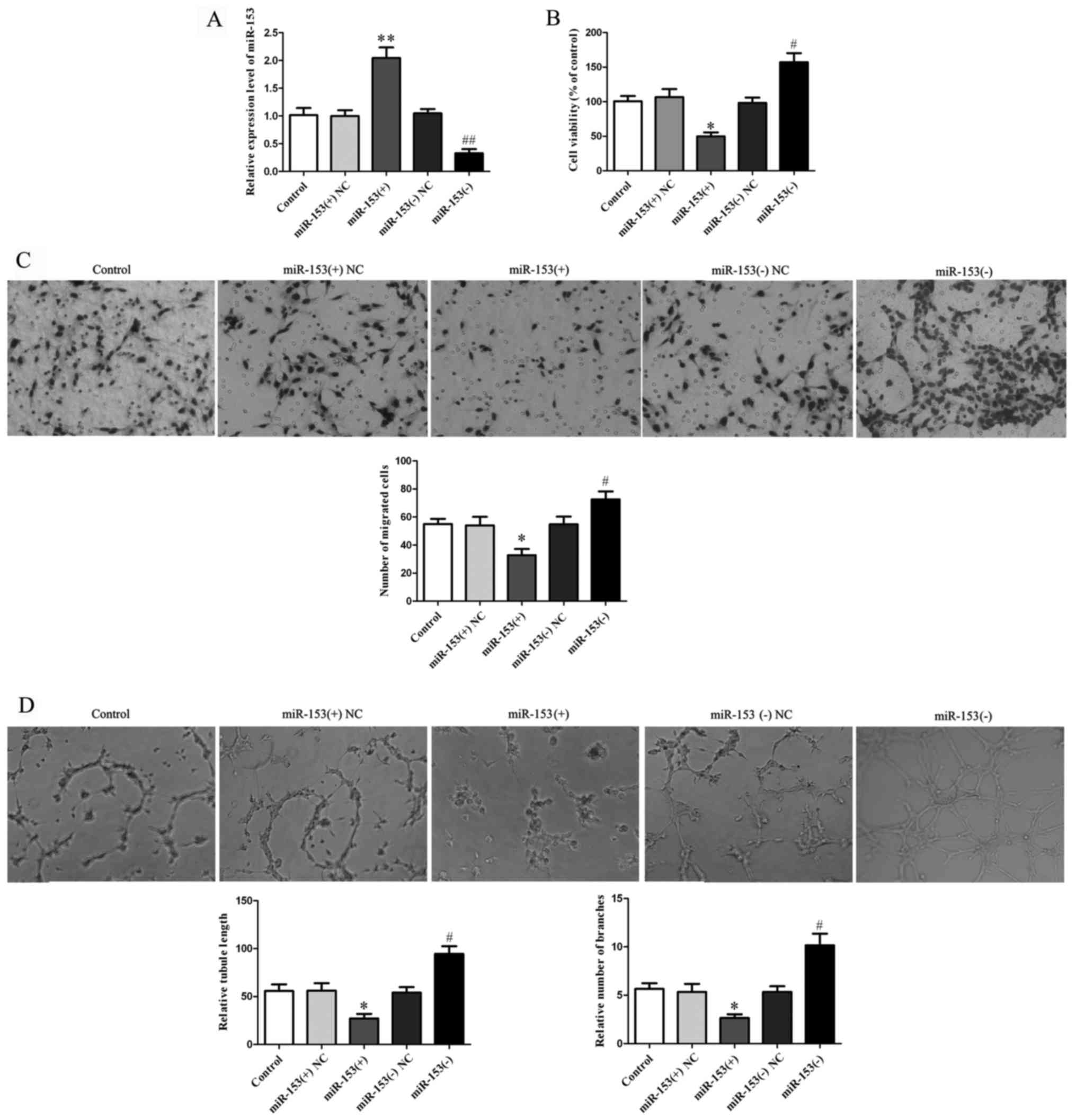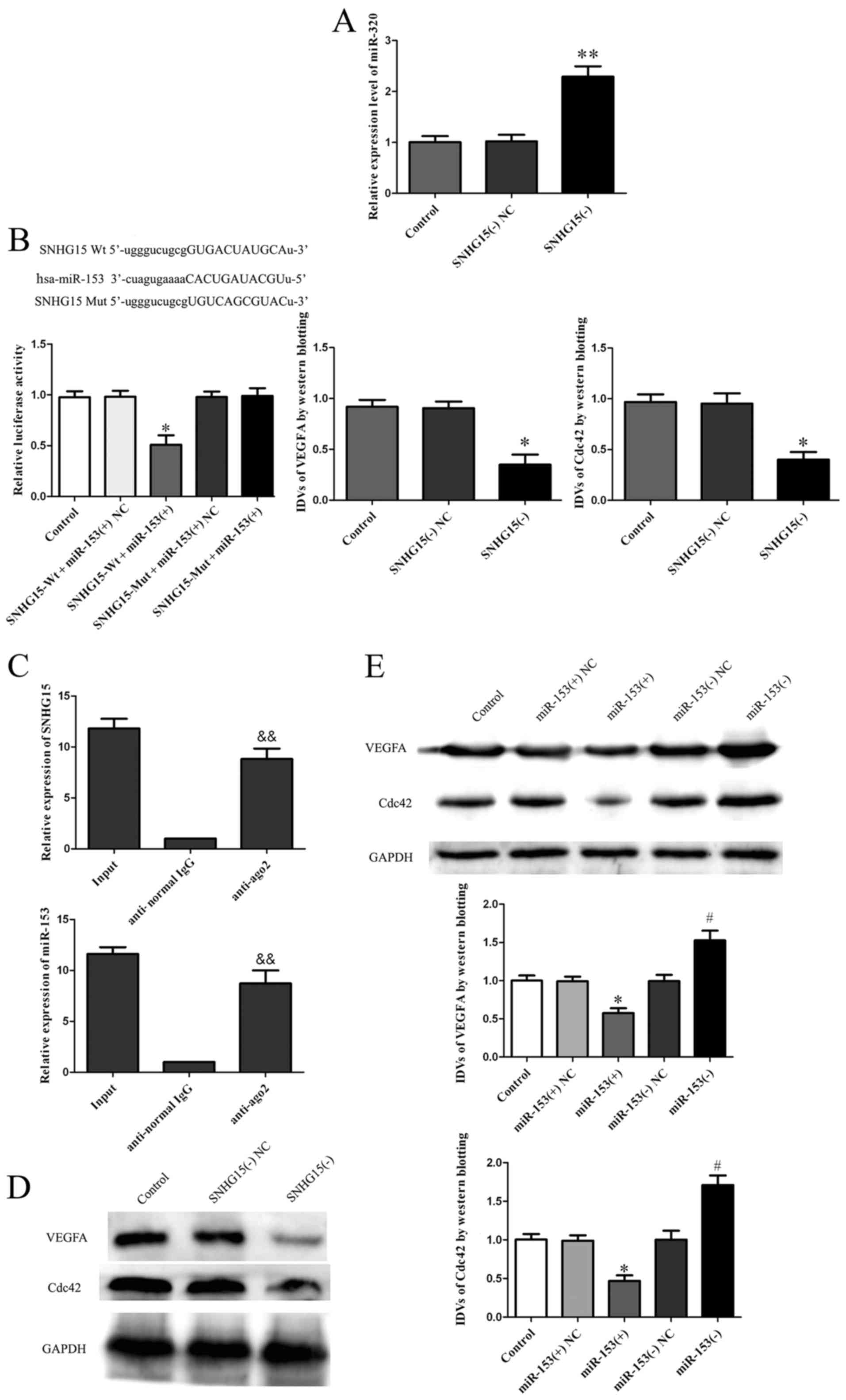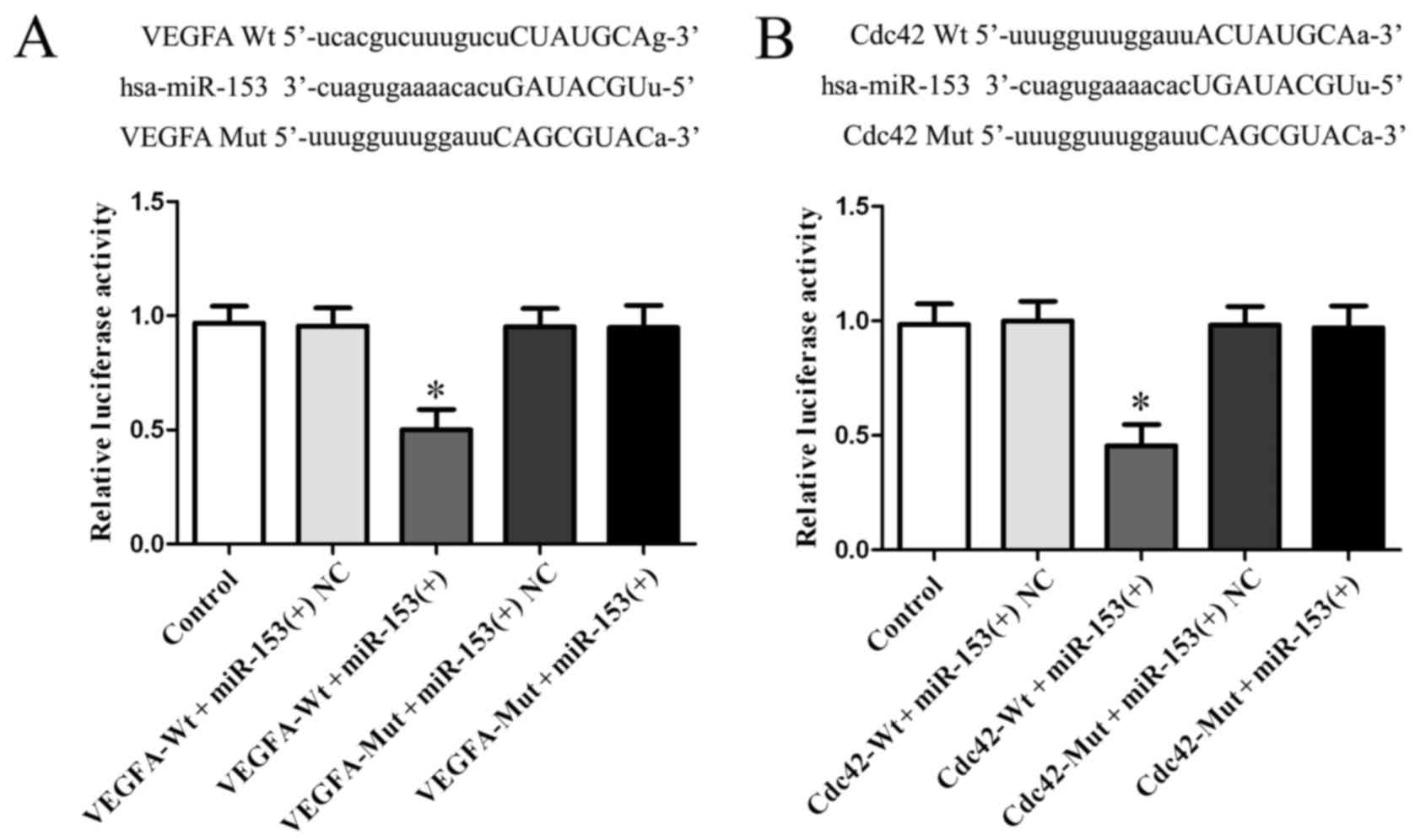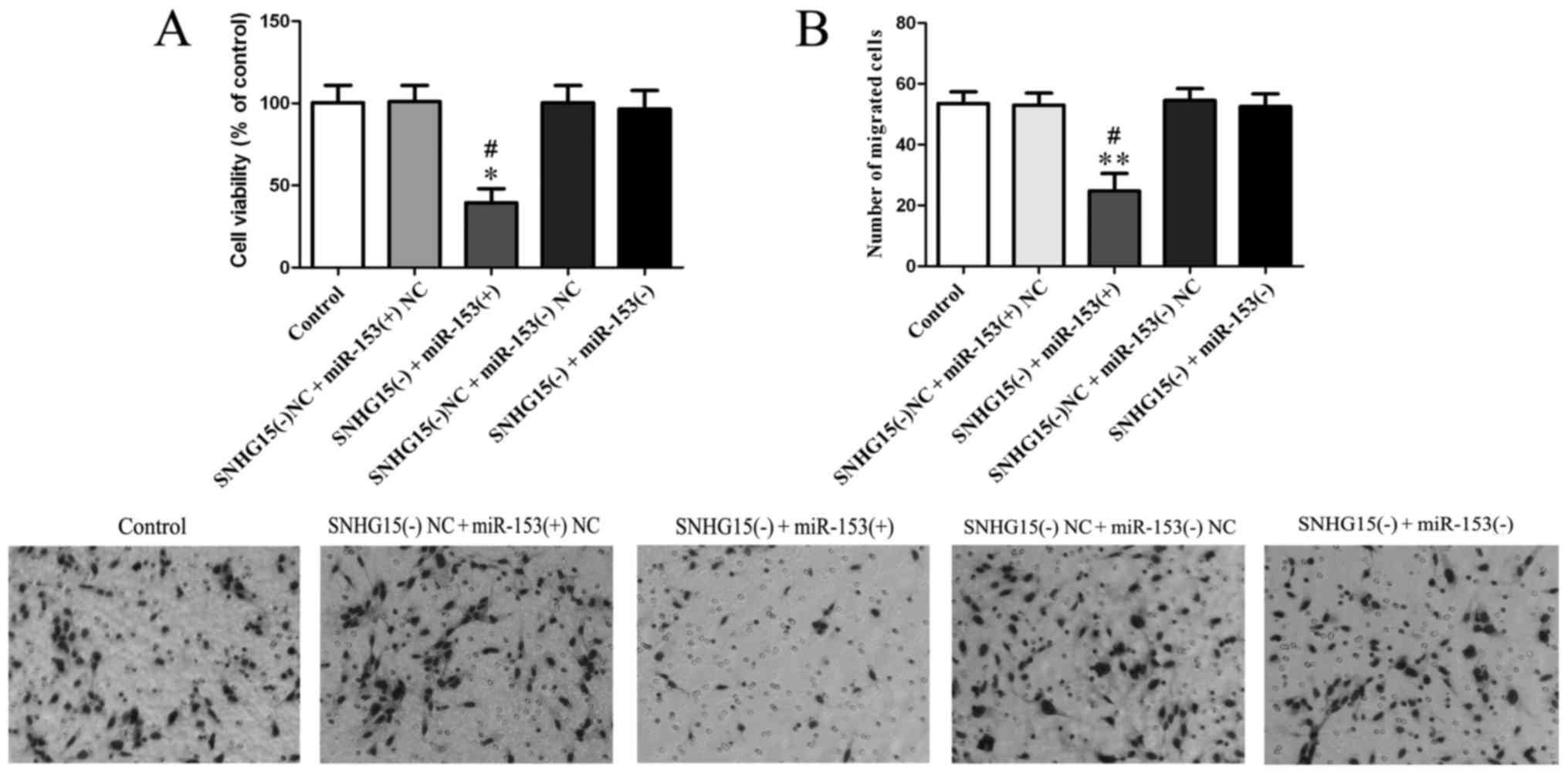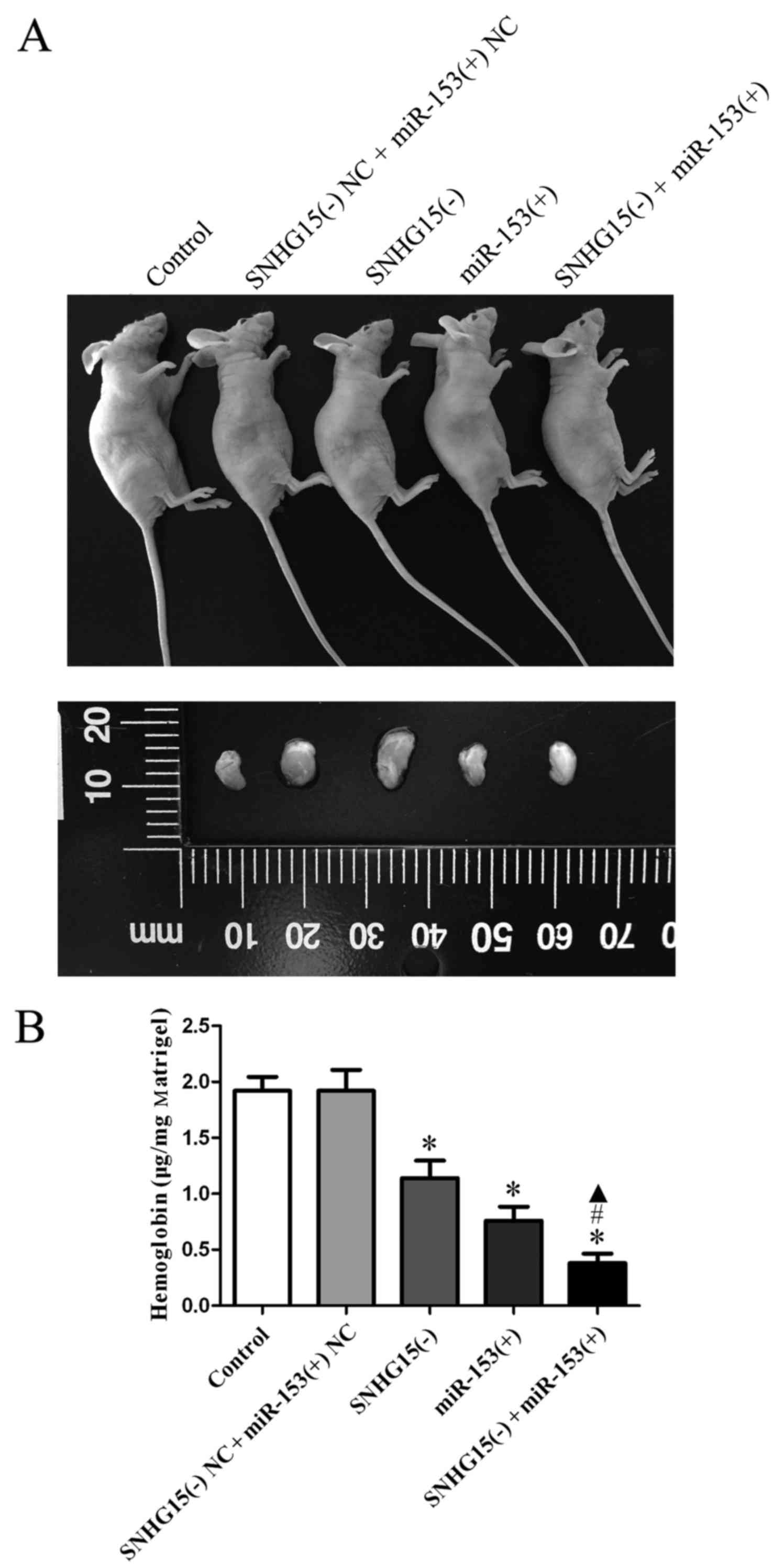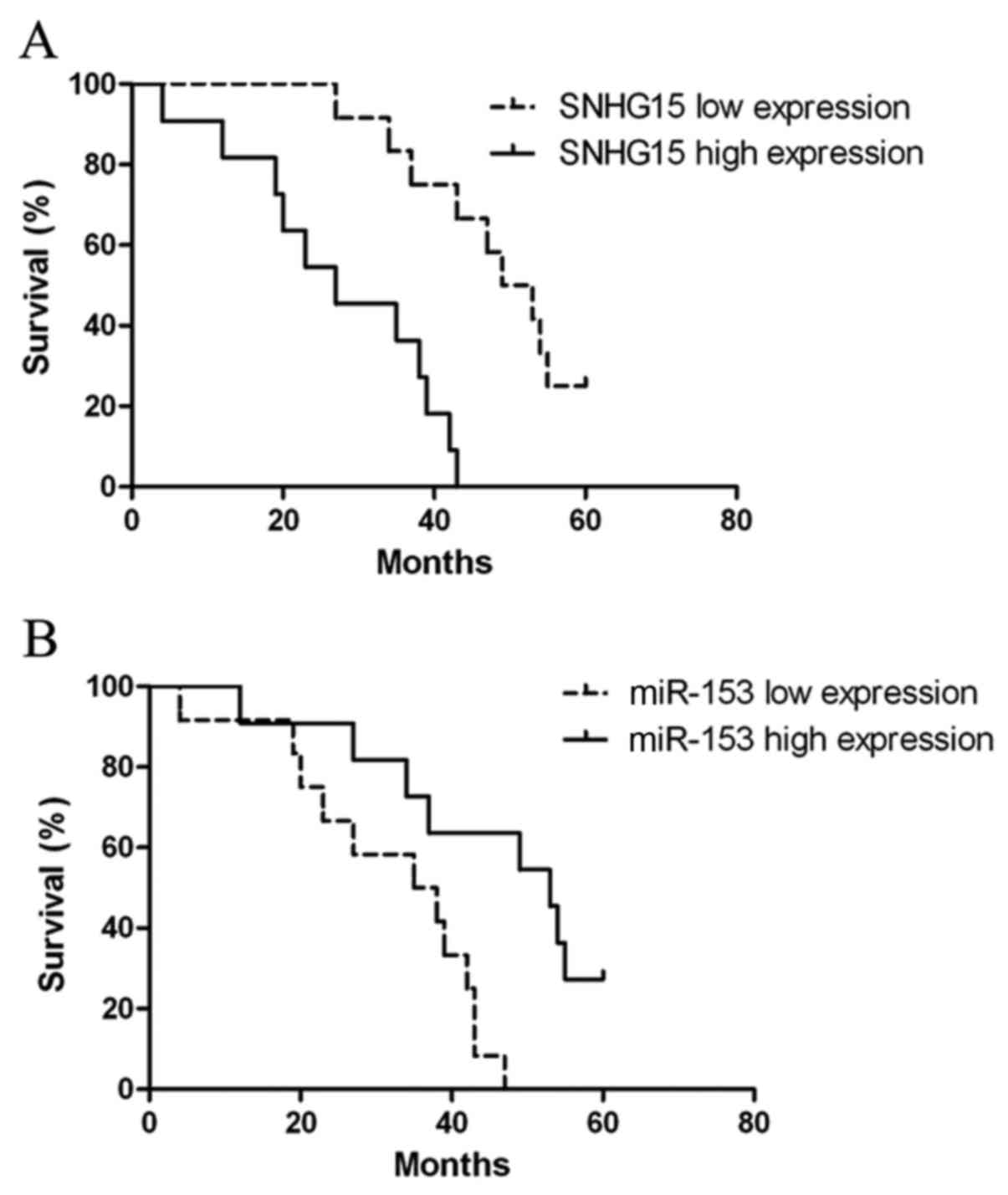SNHG15 affects the growth of glioma microvascular endothelial cells by negatively regulating miR-153
Corrigendum in: /10.3892/or.2022.8267
- Authors:
- Published online on: September 21, 2017 https://doi.org/10.3892/or.2017.5985
- Pages: 3265-3277
Abstract
Introduction
Glioma is the most common intracranial malignant tumor. Owing to the frequent infiltrating nature of glioma lesions, radical surgery is not always feasible. Radiotherapy and chemotherapy are conventional treatments after surgery. However, even after standard treatment, the median survival time of patients remains only 12–15 months after glioblastoma diagnosis (1,2). The poor prognosis of glioblastoma patients has aroused increasing interest in finding new approaches to glioma therapy. Agents directed at molecular targets, such as abnormal signaling pathway or tumor angiogenesis inhibitors, have gained wide attention (3–5). Due to the hypervascular nature of glioblastoma (6), the identification of anti-angiogenesis-targeted chemotherapeutic agents by exploring the regulatory factors of tumor-suppressor genes is promising for the treatment of glioma.
Angiogenesis refers to the formation of new blood vessels from original ones, which is essential for tumor blood supply and is involved in various malignant biological behaviors of tumors including growth, invasion and metastasis (7). Vascular endothelial cell proliferation, migration and tube formation constitute the main steps of the angiogenesis process (8). In the glioma microenviroment, vascular endothelial cells respond to multiple proangiogenetic regulatory factors such as vascular endothelial cell growth factor (VEGF), transforming growth factor α (TGFα) and endothelin-1 directly secreted by tumor cells (9,10). They are also altered in the endogenous gene expession, such as Roundabout4 and miR-125b, which indirectly affects tumor angiogenesis (11,12).
Long non-coding RNAs (lncRNAs) are defined as non-coding RNAs between 200 nt and 100 kb in length. lncRNAs play important roles in diverse biological processes, including embryonic development, cell growth and tumorigenesis, by regulating gene expression at the chromatin organization, transcriptional and post-transcriptional levels (13). Research has shown that abnormalities in lncRNAs are linked to various tumor and non-tumor diseases. For example, expression of lncRNA-HOTAIR was found to be upregulated in multiple malignant tumors including colorectal cancer, hepatocellular carcinoma, pancreatic and prostate cancer as well as glioma, and showed a positive correlation with malignant biological behaviors of the tumors (14–18). Recent studies also found lncRNAs to be involved in the modulation of angiogenesis. Located in 7p13, SNHG15 was found to be highly expressed in hepatocellular carcinoma and gastric cancer (19,20). Nonetheless, the expression and biological effect of SNHG15 in glioma vascular endothelial cells remain unknown.
MicroRNAs (miRNAs) are a class of small non-coding RNAs (18–25 nucleotides) which post-transcriptionally regulate gene expression by negatively regulating the stability or translational efficiency of their target mRNAs (21). Increasing evidence has shown that abnormal expression of miRNAs is involved in tumor formation, progression as well as angiogenesis (22,23). miR-153, involved in the development of a number of tumors, was found to be downregulated in breast, prostate and non-small cell lung cancer as well as glioma (24–27). However, the function of miR-153 in glioma vascular endothelial cells is still unclear.
VEGFA is a member of the PDGF/VEGF growth factor family which encodes a heparin-binding protein that plays predominant roles in angiogenesis by inducing proliferation and migration of vascular endothelial cells. It is upregulated in many known tumors and its expression is correlated with tumor stage and progression (28–30). Cdc42 is a small GTPase of the Rho-subfamily which regulates cytoskeletal dynamics, cell shape, and numerous other cellular processes including polarity, migration, cell cycle progression and cell fate determination. Both VEGFA and Cdc42 have been confirmed to be closely related to angiogenesis.
In the present study, we aimed at investigating the expression levels of SNHG15 and miR-153 in glioma microvascular endothelial cells and the effect of SNHG15 on miR-153-induced regulation of VEGF and Cdc42 as well as the underlying mechanism in the process.
Materials and methods
Reagents and antibodies
Endothelial Basal Medium-2 (EBM-2) was purchased from Lonza (Walkersville, MD, USA). Fetal bovine serum (FBS) ‘Gold’ and 10 mM HEPES were purchased from PAA Laboratories GmbH (Pasching, Austria). Penicillin-streptomycin and chemically defined lipid concentrate were purchased from Invitrogen (Life Technologies, Carlsbad, CA, USA). Cultrex rat collagen I was obtained from R&D Systems (Minneapolis, MN, USA), Human basic fibroblast growth factor (bFGF), hydrocortisone and ascorbic acid were obtained from Sigma-Aldrich (St. Louis, MO, USA). High-glucose Dulbecco's modified Eagles medium (DMEM), DMEM-F12 mixed medium and FBS were purchased from Gibco (Life Technologies). Cell Counting Kit-8 (CCK-8) was purchased from Beyotime Institute of Biotechnology (Jiangsu, China). VEGFA and Cdc42 antibodies were purchased from the ProteinTech Group (Chicago, IL, USA). Antibodies against GAPDH and the secondary antibodies were purchased from Santa Cruz Biotechnology (Santa Cruz, CA, USA).
Cell culture and treatment
Human cerebral microvascular endothelial cells (hCMECs)/D3 were provided by Dr P.-O. Couraud (Institut Cochin, Paris, France). The cells (passage 30–35) were cultured in culture flasks coated with 150 µg/ml of cultrex rat collagen I. Primary glioma cells were derived from intraoperative tissue samples from patients who were diagnosed with primary glioblastoma. Primary astrocyte cells derived from patients undergoing temporal lobe resection for the surgical treatment of intractable epilepsy were used as the negative control (NC). Detailed culture methodology was carried out as previously described (31,32). Immunohistochemistry against GFAP and β-tubulin III was used for identification of glioma (or astrocyte) cells. Cells were stained with anti-GFAP (1:100; Abcam, Cambridge, MA, USA) and anti-β-tubulin III (1:100). Cells were also counterstained with 4,6-diamidino-2-phenylindole (DAPI) to identify all nuclei.
Glioma conditioned medium (GCM) was collected from the indicated primary human glioma cells grown in 100-mm-diameter Petri dishes. Primary astrocyte cell conditioned medium (ACM) was used as the NC. Conditioned medium was prepared from the glioblastoma (or astrocyte) cell culture grown to near confluency. After being washed twice with serum-free medium, the cells were incubated in serum-free EBM-2 medium in a humidified incubator at 37°C with 5% CO2 for 24 h. The supernatant was harvested, centrifuged at 2,000 × g at 4°C for 10 min and supplemented with 5% FBS ‘Gold’, 1% penicillin-streptomycin, 1% chemically defined lipid concentrate, 1 ng/ml bFGF, 1.4 µM hydrocortisone, 5 µg/ml ascorbic acid and 10 mM HEPES, EGF and hydrocortisone prior to use. Primary astrocyte cell conditioned medium was used as NC.
Reverse transcription and quantitative real-time PCR (qRT-PCR)
Total RNA was extracted from cells using TRIzol reagent (Life Technologies). RNA concentration and quality were determined by the 260/280 nm ratio using a NanoDrop spectrophotometer (ND-100). One-Step SYBR PrimeScript RT-PCR kit (Perfect Real-Time) (Takara Bio, Inc., Otsu, Japan) was used for qRT-PCR. The primers for SNHG15 were: 5′-GCATCTCTTCCCACTATCTGC-3′ and 5′-TGGTTTCATCTCCCAGCAC-3′; and for glyceraldehyde-3-phosphate dehydrogenase (GAPDH) 5′-GGTGAAGGTCGGAGTCAACG-3′ and 5′-CCATGTAGTTGAGGTCAATGAAG-3′. TaqMan MicroRNA Reverse Transcription kit (Applied Biosystems, Foster City, CA, USA) was used for miRNA reverse transcription and qRT-PCR was conducted using TaqMan Universal Master Mix II with TaqMan microRNA assays of miR-153 and U6, respectively. U6 and GAPDH were used as endogenous controls for miRNA and gene expression detection. Expression levels were normalized to endogenous controls, and the relative quantification (2−ΔΔCt) method was used for fold change calculation.
Cell transfections
The sh-SNHG15 plasmid and its respective non-targeting sequence (NC); pre-miR-153 and anti-miR-153 plasmid, and their respective non-targeting sequences were synthesized (GenePharma, Shanghai, China). Cells were seeded into 24-well plates (Corning Inc., Corning, NY, USA) until they achieved 50–70% confluence, and then transfected using Opti-MEM I and Lipofectamine 2000 reagent (Life Technologies Corporation, Carlsbad, CA, USA). After 6 h of transfection, the medium was replaced with EBM-2 medium with 10% FBS. The applicable stably transfected cells were selected using G418 screening. The overexpression and the silencing efficiency were analyzed using qRT-PCR. To determine the effect of SNHG15 on glioma vascular endothelial cells (ECs), cells were divided into 3 groups: control, SNHG15(−) NC (transfected with sh-NC plasmid) and SNHG15(−) group (transfected with sh-SNHG15 plasmid). To determine the effect of miR-153 on glioma vascular ECs, cells were divided into 5 groups: control, miR-153(+) NC (transfected with pre-miR-153 NC plasmid), miR-153(+) (transfected with pre-miR-153 plasmid), miR-153(−) NC (transfected with anti-miR-153-NC plasmid) and miR-153(−) group (transfected with anti-miR-153 plasmid). To determine whether SNHG15-mediated regulation of miR-153 expression regulated the behavior of ECs, cells were divided into 5 groups: control, SNHG15(−) NC + miR-153(+) NC group (transfected with both sh-NC plasmid and pre-miR-153-NC plasmid), SNHG15(−) + miR-153(+) group (transfected with both sh-SNHG15 plasmid and pre-miR-153 plasmid), SNHG15(−) NC + miR-153(−) NC group (transfected with both sh-NC plasmid and anti-miR-153-NC plasmid), SNHG15(−) + miR-153(−) group (transfected with both sh-SNHG15 plasmid and anti-miR-153 plasmid).
Cell proliferation assay
ECs were seeded into 96-well plates at the density of 2,000 cells/well, and cell viability rate was assayed using CCK-8 (Beyotime Institute of Biotechnology) according to the instructions provided by the manufacturer. CCK-8 (10 µl) was added into each well and cells were incubated for another 2 h in a humidified incubator. Optical density value was measured at 450 nm. Five replicate wells were set up in each group and 3 independent repeated experiments were performed.
Cell migration assay
EC migration in vitro was assayed using a Transwell chamber (Costar, Corning, NY, USA) with a polycarbonate membrane (6.5-mm in diameter, 8-µm pore size). ECs were trypsinized and suspended into single cells with serum-free medium at the density of 5×105 cells/ml. Cell suspension (100 µl) was added to the upper chamber, and 600 µl of GCM supplemented with 10% FBS was added to the lower chamber. Cells were incubated for 12 h at 37°C. Non-migrating cells on the top surface of the membrane were removed with cotton swabs. Cells that migrated to the lower surface of the membrane were fixed with methanol and glacial acetic acid in a 3:1 ratio, stained with 20% Giemsa solution for 30 min at 37°C and were washed twice with phosphate-buffered saline (PBS). Then, stained cells were observed under an inverted microscope to count the cell number within five randomly chosen fields at a magnification of ×200 and the average number was calculated.
Tube formation assay
We used standard Matrigel assay to evaluate in vitro angiogenesis activity by quantifying the tube formation, as previously described (11). Culture plates (48-well) were coated with 200 µl of Matrigel (BD Biosciences, Bedford, MA, USA) per well, and then allowed to polymerize for 30 min at 37°C. Confluent cells were suspended in fresh GCM at the density of 1.5×105 cells/ml. Cell suspension (100 µl) was seeded in wells of a 48-well culture plate polymerized Matrigel and incubated at 37°C for 12 h. Each culture was photographed at a magnification of ×100 using Olympus DP71 immunofluorescence microscopy (Olympus, Tokyo, Japan), and total tubule length and number of tubule branches were measured using ChemiImager 5500 V2.03 software (Alpha Innotech).
Western blot assay
Cells were lysed and the supernatant extracts were quantified for protein using the BCA protein assay kit (Beyotime Institute of Biotechnology). Total cell lysates containing 40 µg of protein were fractionated using SDS-PAGE and transferred onto polyvinylidene fluoride (PVDF) membranes (Millipore, Billerica, MA, USA). After blocking with 5% non-fat dry milk in Tris-buffered saline with Tween-20 (TBST) for 2 h, the membranes were incubated with primary antibodies (anti-GAPDH antibody diluted at 1:1,000; anti-VEGFA antibody diluted at 1:500; anti-Cdc42 antibody diluted at 1:500) at 4°C overnight. After 3 washes with PBS-Tween (20 mM Tris, 137 mM NaCl, 0.1% Tween-20, pH 7.6), the membranes were incubated with the corresponding HRP-conjugated secondary antibody (diluted at 1:5,000) at room temperature for 2 h. Protein bands were visualized by ECL (Santa Cruz Biotechnology) and detected using the ECL Detection System (Thermo Scientific, Waltham, MA, USA). Then, the protein bands were scanned using ChemiImager 5500 V2.03 software, and integrated light density values (IDVs) were calculated by Fluor Chen 2.0 software and normalized with those of GAPDH.
Reporter vector construction and luciferase assays
SNHG15 3-untranslated region (3′-UTR), VEGFA 3′-UTR and Cdc42 3′-UTR sequences were amplified by PCR and cloned into a pmirGlo Dual-luciferase MiRNA Target Expression Vector (Promega, Madison, WI, USA) to construct 3′-UTR-luciferase reporter vector (SNHG15-WT, VEGFA-WT and Cdc42-WT) (GenePharma). The sequence of the putative binding site was replaced as indicated (SNHG15-Mut, VEGFA-Mut and Cdc42-Mut) to mutate the putative binding site of miR-153 in the 3′-UTR-containing vector. Glioma vascular ECs were seeded in 96-well plates and the cells were co-transfected with SNHG15-WT (or SNHG15-Mut), VEGFA-WT (or VEGFA-Mut) or Cdc42-WT (or Cdc42-Mut) and miR-153 plasmids (or miR-153-NC) when they reached 50–70% confluence. The luciferase activities were measured at 48 h after transfection using the Dual-Luciferase Reporter Assay kit (Promega). The cells were divided in 5 groups, respectively: control, SNHG15-WT + miR-153(+) NC, SNHG15-WT + miR-153(+), SNHG15-Mut + miR-153(+) NC and SNHG15-Mut + miR-153(+) group; control, VEGFA-WT + miR-153(+) NC, VEGFA-WT + miR-153(+), VEGFA-Mut + miR-153(+) NC and VEGFA-Mut + miR-153(+) group; control, Cdc42-WT + miR-153(+) NC, Cdc42-WT + miR-153(+), Cdc42-Mut + miR-153(+) NC and Cdc42-Mut + miR-153(+) group.
RNA-binding protein immunoprecipitation (RIP) assay
RNA-RIP was assayed using a Magna RNA-RIP kit (Millipore) according to the manufacturers instructions. Briefly, the glioma vascular ECs were lysed in complete RNA lysis buffer. Whole cell lysate was incubated with RIP buffer containing magnetic beads conjugated with human anti-Argonaute2 (Ago2) antibody, and NC normal mouse IgG (both from Millipore). Samples were incubated with proteinase K, and then immunoprecipitated RNA was isolated. The RNA concentration was measured using a spectrophotometer (NanoDrop; Thermo Scientific) and the RNA quality assessed using a bioanalyzer (Agilent, Santa Clara, CA, USA). Furthermore, purified RNAs were extracted and analyzed by qRT-PCR to demonstrate the presence of the binding targets.
In vivo Matrigel plug assay
All experimental animal procedures were strictly conducted in accordance with the Guide for the Care and Use of Laboratory Animals, and approved by the Animal Care and Use Committee of Shengjing Hospital. The male BALB/c athymic nude mice (randomized to each group by 3 observers in a blinded manner, n=7/group, 4–6 weeks old) were obtained from the Cancer Institute of the Chinese Academy of Medical Sciences. Angiogenesis was also measured by a Matrigel plug assay as previously described (33). Briefly, 3×106 GECs in 400 µl of solution containing 80% Matrigel were subcutaneously injected. Plugs were harvested after 4 days, weighed, photographed and dispersed in 400 µl of PBS (overnight incubation at 4°C) to collect the hemoglobin. Hemoglobin content was measured using Drabkin's solution (Sigma-Aldrich) according to the manufacturer's recommendations.
Patients and specimens
The present study was approved by the Institutional Review Board of Shengjing Hospital of China Medical University and each patient signed a consent form to participate in the present study. Human glioma specimens were obtained from primary patients diagnosed with glioma who underwent gross total tumor resection at the Department of Neurosurgery of Shengjing Hospital, China Medical University, from April 2010 to January 2011. None of these patients had undergone chemotherapy or radiotherapy before surgery, and specimens were collected immediately after tumor excision during surgery. All glioma cases were pathologically confirmed. Patient survival information was acquired via out-patient review, telephone and mail. Overall survival was calculated from the date of the initial surgical operation to death from primary tumor-related causes or up to December 2013, whichever came first. The follow-up rate was 100% and median follow-up period was 39 months (range, 4–60 months).
Statistical analysis
Statistical analysis was performed using SPSS 18.0 statistical software. One-way ANOVA followed by Bonferroni post hoc test was used to analyze the difference between two groups. Data are expressed as mean ± standard deviation (SD). P<0.05 was considered to indicate a statistically significant result.
Results
SNHG15 is highly expressed in glioma-induced hCMECs, VEGFA and Cdc42 are upregulated in glioma-induced hCMECs while miR-153 is lowly expressed in glioma-induced hCMECs
SNHG15 and miR-153 expression levels in hCMECs in GCM and primary astrocyte cell conditioned medium were detected by qRT-PCR. The SNHG15 expression level in glioma conditioned hCMECs was increased compared with this level in the hCMECs in ACM (P<0.05; Fig. 1A). miR-153 expression level in glioma conditioned hCMECs was decreased compared with that in the hCMECs in ACM (P<0.05; Fig. 1B). Western blotting of VEGFA and Cdc42 found increased expression of VEGFA and Cdc42 in the hCMECs in GCM compared with these levels in the hCMECs in ACM (P<0.05; Fig. 1C).
Knockdown of SNHG15 inhibits proliferation, migration and tube formation of glioma vascular endothelial cells
After investigation of the expression level of SNHG15 in glioma vascular ECs, we further investigated the effect of SNHG15 on proliferation, migration and tube formation of glioma vascular ECs. The stable transfected EC line with knockdown of SNHG15 was established. Expression of SNHG15 was 68.12% lower in the SNHG15(−) group than that noted in the SNHG15(−) NC group (P<0.01; Fig. 2A). Subsequently, CCK-8 assay was performed to assess the effect of SNHG15 knockdown on cell proliferation. The viability was lower in the SNHG15(−) group than that noted in the SNHG15(−) NC group (P<0.05; Fig. 2B). Cell migration assay found that compared with the SNHG15(−) NC group, the SNHG15(−) group showed a decrease in the migrated cell number (P<0.05; Fig. 2C). Results of the tube formation assay showed that relative tubule length and relative number of branches were lower in the SNHG15(−) group in contrast to these parameters in the SNHG15(−) NC group (P<0.05; Fig. 2D).
Knockdown of miR-153 promotes proliferation, migration and tube formation of glioma vascular endothelial cells
After investigation of miR-153 expression in glioma vascular ECs, we further analyzed the effect on proliferation, migration and tube formation of glioma vascular ECs. The expression of miR-153 was 110.4% higher in the miR-153(+) group than that noted in the miR-153(+) NC group and was 66.12% lower in the miR-153(−) group than that in the miR-153(−) NC group (P<0.01; Fig. 3A). CCK-8 assay found that the viability was significantly lower in the miR-153(+) group (P<0.01; Fig. 3B) and higher in the miR-153(−) group (P<0.05; Fig. 3B), in contrast to the miR-153(+) NC and miR-153(−) NC group, respectively. Cell migration assay results showed that the miR-153(+) group had a decreased migratory cell number compared with the miR-153(+) NC group while the miR-153(−) group had an increased migratory cell number compared with that noted in the miR-153(−) NC group (P<0.05; Fig. 3C). Results of the tube formation assay showed that the miR-153(+) group had a decreased relative tubule length and relative number of branches while the miR-153(−) group had enhanced tube formation in vitro (P<0.05; Fig. 3D).
SNHG15 binds to and negatively regulates miR-153
According to the bioinformatic database (RNAhybrid), we predicted that SNHG15 may be associated with the miR-153 binding sites. Furthermore, dual-luciferase gene reporter assay proved that SNHG15 could bind to miR-153 at the predicted binding sites. Quantitative RT-PCR results demonstrated that miR-153 expression was upregulated in the SNHG15(−) group compared to the SNHG15(−) NC group (P<0.01; Fig. 4A). Results of dual-luciferase gene reporter assay showed that the luciferase activity in the SNHG15-Wt + miR-153(+) group was lower than that in the SNHG15-Wt + miR-153(+) NCgroup (P<0.05, Fig. 4B), indicating that SNHG15 bound to miR-153 and negatively regulated its expression. To determine whether SNHG15 is associated with the RNA-induced silencing complex (RISC), we performed RNA-RIP assay. The RNA levels of SNHG15 and miR-153 were higher in the anti-Ago2 group than levels in the anti-normal IgG group (P<0.01; Fig. 4C).
Knockdown of SNHG15 downregulates the expression of VEGFA and Cdc42 while knockdown of miR-153 upregulates the expression of VEGFA and Cdc42
Western blotting of VEGFA and Cdc42 indicated decreased expression of VEGFA and Cdc42 in the SNHG15(−) group compared with levels in the SNHG15(−) NC group (P<0.05; Fig. 4D). Furthermore, the expression of VEGFA and Cdc42 was lower in the miR-153(+) group in contrast to the miR-153(+) NC group and higher in the miR-153(−) group compared with the miR-153(−) NC group (P<0.05; Fig. 4E).
miR-153 binds to the 3′-UTR of VEGFA and Cdc42
To investigate the targeted binding effect of miR-153 to VEGFA and Cdc42, we searched the bioinformatic databases (TargetScan, miRanda). Using TargetScan and miRanda we found putative binding sites of miR-153 in the 3′-UTR of VEGFA and 3′-UTR of Cdc42. To verify the combination between miR-153 and the 3′-UTR of VEGFA and Cdc42, we performed dual-luciferase reporter assay. Results showed that luciferase activity of VEGFA-Wt + miR-153(+) and Cdc42-Wt + miR-153(+) group was lower than VEGFA-Wt + miR-153(+) NC or Cdc42-Wt + miR-153(+) NC group (P<0.05; Fig. 5A), while no significant difference was found between VEGFA-Mut + miR-153(+) and VEGFA-Wt + miR-153(+) NC group or between Cdc42-Mut + miR-153(+), and Cdc42-Wt + miR-153(+) NC group (P>0.05, Fig. 5A), which indicated that miR-153 bound with 3′-UTR of VEGFA and Cdc42 by the putative binding sites.
Knockdown of SNHG15 affects the biological behaviors of glioma vascular endothelial cells and VEGFA as well as Cdc42 expression by negative regulation of miR-153
To investigate whether SNHG15 affects the biological behaviors of glioma vascular ECs by regulation of miR-153 and its mechanism, we knocked down SNHG15 expression and also both knocked down and overexpressed miR-153 simultaneously in the ECs. CCK-8 assay results showed that the viability of the SNHG15(−) + miR-153(+) group was lower than both SNHG15(−) + miR-153(+) NC (P<0.05; Fig. 6A) and SNHG15(−) + miR-153(−) groups (P<0.05; Fig. 6A).
The results of the cell migration assay showed that the SNHG15(−) + miR-153(+) group had a decreased number of migrated cells compared with the SNHG15(−) + miR-153(+) NC and SNHG15(−) + miR-153(−) groups (P<0.05; Fig. 6B).
The tube formation assay found that the SNHG15(−) + miR-153(+) group showed a decreased relative tubule length and a decreased relative number of branches compared with the SNHG15(−) + miR-153(+) NC and SNHG15(−) + miR-153(−) groups (P<0.05; Fig. 6C).
Western blot analysis found that in the SNHG15(−) + miR-153(+) group, VEGFA and Cdc42 expression was downregulated in contrast to levels in the SNHG15(−) + miR-153(+) NC and SNHG15(−) + miR-153(−) groups (P<0.05; Fig. 6D).
SNHG15 knockdown combined with miR-153 overexpression suppresses angiogenesis
Angiogenesis was also measured by a Matrigel plug assay; the combinations of transfection were conducted prior to the assessment of angiogenesis. The results revealed that the amount of hemoglobin in the SNHG15(−), miR-153(+) and SNHG15(−) + miR-153(+) groups was significantly decreased compared with that in the SNHG15(−) NC + miR-153(+) NC group, and the amount of hemoglobin in the SNHG15(−) + miR-153(+) group was found to be the least among all the groups (P<0.05; Fig. 7B).
Association of SNHG15 and miR-153 expression with the survival of glioma patients
Kaplan-Meier analysis and log-rank test were conducted to calculate the effects of SNHG15 and miR-153 on patient survival. The overall survival rate was 17.39% (4 out of 23 patients). The median survival time of patients with low SNHG15 expression was 51 months, whereas the median survival time of those with SNHG15 high expression was only 27 months. In log-rank test, the results showed that patients with glioma of high SNHG15 expression tended to have poorer overall survival (log-rank test P<0.001; Fig. 8A). The median survival time of patients with low miR-153 expression was 36.5 months, whereas the median survival time of those with miR-153 high expression was 53 months. In log-rank test, the results showed that patients with glioma of high miR-153 expression tended to have better overall survival (log-rank test P<0.01; Fig. 8B).
Discussion
In the present study, we found that SNHG15 was highly expressed in glioma-induced endothelial cells while miR-153 was lowly expressed in glioma-induced endothelial cells. Knockdown of SNHG15 or overexpression of miR-153 inhibited the proliferation, migration and tube formation of glioma vascular endothelial cells as well as decreased the expression of VEGFA and Cdc42. SNHG15 was capable of binding to miR-153 and negatively regulating its function. miR-153 targeted the 3′-UTR of VEGFA and Cdc42, inhibiting their expression. SNHG15 affected proliferation, migration and tube formation through negative regulation of miR-153.
Tumor angiogenesis is a critical process during cancer progression that modulates tumor growth and metastasis. Solid tumors cannot grow beyond 2–3 mm in diameter without inducing the formation of new blood vessels to support the energetic requirements of tumor cells (7). As for glioma, high microvessel density in glioma correlates with tumor grade and is regarded as an independent marker of poor patient prognosis (34), while glioblastoma has been generally considered to be among the most highlly vascularized tumor in humans (35). Vascular endothelial cells, as the most important component of tumor vascularity, are the main target through which glioma regulates angiogenesis by secretion of multiple pro-angiogenic growth factors (9,10). Further study showed that the glioma microenvironment also triggered change in the expression of multiple genes in vascular endothelial cells and whether this change takes part in glioma angiogenesis remains controversal (36,37).
Recent studies have verified that lncRNAs not only affect the biological behaviors of tumor cells directly, but also modulate the function of tumor vascular endothelial cells. SNHG15, firstly identified as one of the lncRNAs that respond to chemical stressors [cisplatin, cycloheximide and mercury (II) oxide] in HeLa Tet-off cells, was also found to be an oncogene (19,20,38). Zhang et al showed that SNHG15 was highly expressed in hepatocellular carcinoma and associated with poor overall survival of patients (20). Furthermore, Chen et al demonstrated that upregulated expression of SNHG15 promoted cell proliferation and invasion in patients with gastric cancer (19). To investigate whether SNHG15 affects the function of glioma vascular endothelial cells, we firstly detected the expression level of SNHG15 in glioma conditioned endothelial cells and found that SNHG15 was highly expressed in glioma vascular endothelial cells. We further studied the effect of SNHG15 on glioma vascular endothelial cell function. Knockdown of SNHG15 inhibited proliferation, migration and tube formation in vitro. In recent years, accumulating evidence has demonstrated that lncRNAs are involved in the regulation of various biological behaviors of endothelial cells. Overexpression of lncRNA-NONHSAT073641 was shown to increase sprout number and length as well as branch number and tubule length in HUVECs, thus promoting endothelial angiogenic function (39). Michalik et al verified that lncRNA-MALAT1 inhibited human umbilical vein endothelial cell migration, but promoted endothelial cell proliferation and angiogenesis (40). He et al confirmed that lncRNA-p21 induced vascular endothelial cell apoptosis (41). Similarly, in the present study, SNHG15 promoted glioma vascular endothelial cell proliferation, migration and tube formation in vitro. These findings highlight the important role of lncRNAs in the regulation of vascular endothelial cell function.
miRNAs are involved in various biological processes of tumor and vascular endothelial cells. miR-153 was first discovered as 1 of the 7 brain-specific miRNAs based on expression analysis of 119 miRNAs in adult organs from the mouse and human using Northern blot analysis (42). In glioma, the study of Silber et al showed that the expression level of miR-153 was significantly decreased in GBM multiforme relative to non-neoplastic brain tissue and a recent study by Cui et al further demonstrated the inhibitory function of miR-153 on the growth of glioma cells. To study the effect of miR-153 on glioma vascular endothelial cells, we detected the expression level of miR-153 in glioma conditioned vascular endothelial cells and found that miR-153 expression was downregulated in glioma vascular endothelial cells. Further study by overexpression of miR-153 showed suppressed proliferation, migration and tube formation of the endothelial cells, which suggested that the abnormal decrease in miR-153 expression possibly contributed to the growth of glioma vascularity. Recently, increasing attention has been paid to the influence of miRNAs on endothelial cell function. miR-542-3p was found to inhibit angiogenesis of vascular endothelial cells both in vivo and in vitro (43). Moreover, miR-18a inhibited proliferation and migration of choroid endothelial cells (44). The present study showed that overexpression of miR-153 inhibited proliferation, migration and in vitro tube formation of glioma vascular endothelial cells, suggesting that miR-153 could become a potential target for glioma anti-angiogenesis therapy.
VEGFA has long been recognized as essential for vasculogenesis, the differentiation of endothelial cell progenitors and their assembly into a primary capillary plexus, and for angiogenesis, or the sprouting of new capillaries from pre-existing vessels (45). VEGF is also the most important mediator of neovascularization associated with diverse human diseases including cancer (46). Cui et al demonstrated that the conditioned medium of esophageal squamous cell carcinoma induced a 12-fold upregulation of VEGFA in HUVECs, which underlines the role of endogenous VEGFA in vascular endothelial cells under the tumor microenvironment (47). Cdc42 has been proven to play an important role in neovascularization and vascular biology. Despite its roles in lumen formation, regulating endothelial cell cytoskeleton and restoring endothelial cell barrier function, Cdc42 was also shown to improve VEGF-driven angiogenesis (48–51). Hoang et al showed that Cdc42 improved neovessel architecture and lumen formation in vivo and coordinated microtubules and actin filaments and improved capillary morphogenesis in vitro (48). The results of the present study showed that both VEGFA and Cdc42 expression was upregulated in glioma vascular endothelial cells while knockdown of SNHG15 and overexpression of miR-153 downregulated the expression of VEGFA and Cdc42, which lead to inhibition of proliferation, migration and tube formation of endothelial cells.
miRNAs modulate target gene expression by binding to the 3′-UTR of their target genes. Jin et al demonstrated that miR-214 regulates endothelial progenitor cell function via targeting the 3′-UTR of VEGF. Tang et al demonstrated that overexpression of miR-185 inhibited glioma cell invasion by targeting the 3′-UTR of Cdc42. Using several bioinformatic databases (TargetScan, miRanda), we identified the 3′-UTR of VEGFA and Cdc42 as binding sites for miR-153. We further confirmed the combination between miR-153 and 3′-UTR of VEGFA as well as Cdc42 by dual-luciferase reporter assay.
lncRNAs interact with miRNAs, as lncRNAs function as endogenous sponge or bait, thus negatively regulating expression and activity of miRNAs (52). In the present study, we identified the effects of SNHG15 and miR-153 on endothelial cell function. The present study also showed that knockdown of SNHG15 in vascular endothelial cells led to a significant increase in miR-153 expression, indicating that miR-153 was involved in the effect of SNHG15 on endothelial cells. We found a binding site between SNHG15 and miR-153 according to a bioinformatic database (RNAhybrid). We further confirmed that SNHG15 was capable of binding to miR-153 by dual-luciferase reporter assay, which indicated that SNHG15 may affect the function of endothelial cells by regulating miR-153. The results of the RIP assay also support the involvement of RNA-induced silencing complex in this reciprocal repression process, which indicated that SNHG15 may affect the function of endothelial cells by regulating miR-153. To investigate whether SNHG15 affected the biological behaviors of endothelial cells through regulation of miR-153, we transfected the cells with knockdown of SNHG15 and both overexpression or knockdown of miR-153 simultaneously. The results revealed that knockdown of SNHG15 along with overexpression of miR-153 suppressed, to the greatest extent, endothelial cell proliferation, migration, tube formation and decreased the expression of VEGFA and Cdc42, while knockdown of miR-153 reversed the suppressing effect of the knockdown of SNHG15 on endothelial cell function and expression of VEGFA and Cdc42. In addition, the in vivo studies also supported the above findings. The results above suggest that SNHG15 affected glioma vascular endothelial cells through negative regulation of miR-153. Interaction with miRNAs is a common way of lncRNA function in vascular endothelial cells. Yan et al showed that lncRNA-MIAT affected proliferation, migration and angiogenesis of vascular endothelial cells by binding with miR-150-5p (41).
To elucidate the effect of SNHG15 and miR-153 on glioma prognosis, we investigated the association of SNHG15 and miR-153 expression with the survival of glioma patients. Our results demonstrated that SNHG15 is a potential prognostic factor for glioma patients, and has a negative impact on overall survival of primary glioma patients while miR-153 showed a contrasting result.
In summary, this is the first study to demonstrate that SNHG15 is highly expressed in glioma-induced endothelial cells while miR-153 is lowly expressed in glioma-induced endothelial cells. SNHG15 negatively regulates the expression of miR-153 and miR-153 negatively regulates the expression of VEGFA and Cdc42, which in turn affects glioma vascular endothelial cell proliferation, migration and tube formation in vitro. Therefore, we suggest that SNHG15 and miR-153 are novel targets for glioma anti-angiogenesis therapy.
Acknowledgements
The present study was supported by grants from the Natural Science Foundation of China (nos. 81573010 and 81672511), the Liaoning Science and Technology Plan Project (no. 2015225007), the Shenyang Science and Technology Plan Projects (nos. F15-199-1-30 and F15-199-1-57) and the Outstanding Scientific Fund of Shengjing Hospital (no. 201304).
References
|
Weller M, Van den Bent M, Hopkins K, Tonn JC, Stupp R, Falini A, Cohen-Jonathan-Moyal E, Frappaz D, Henriksson R, Balana C, et al European Association for Neuro-Oncology (EANO) Task Force on Malignant Glioma, : EANO guideline for the diagnosis and treatment of anaplastic gliomas and glioblastoma. Lancet Oncol. 15:e395–e403. 2014. View Article : Google Scholar : PubMed/NCBI | |
|
Dimberg A: The glioblastoma vasculature as a target for cancer therapy. Biochem Soc Trans. 42:1647–1652. 2014. View Article : Google Scholar : PubMed/NCBI | |
|
Polivka J Jr, Polivka J, Rohan V, Topolcan O and Ferda J: New molecularly targeted therapies for glioblastoma multiforme. Anticancer Res. 32:2935–2946. 2012.PubMed/NCBI | |
|
Patel M, Vogelbaum MA, Barnett GH, Jalali R and Ahluwalia MS: Molecular targeted therapy in recurrent glioblastoma: Current challenges and future directions. Expert Opin Investig Drugs. 21:1247–1266. 2012. View Article : Google Scholar : PubMed/NCBI | |
|
Yang W, Barth RF, Huo T, Nakkula RJ, Weldon M, Gupta N, Agius L and Grecula JC: Radiation therapy combined with intracerebral administration of carboplatin for the treatment of brain tumors. Radiat Oncol. 9:252014. View Article : Google Scholar : PubMed/NCBI | |
|
Brem S, Cotran R and Folkman J: Tumor angiogenesis: A quantitative method for histologic grading. J Natl Cancer Inst. 48:347–356. 1972.PubMed/NCBI | |
|
Lopes-Bastos BM, Jiang WG and Cai J: Tumour-endothelial cell communications: Important and indispensable mediators of tumour angiogenesis. Anticancer Res. 36:1119–1126. 2016.PubMed/NCBI | |
|
Zecchin A, Borgers G and Carmeliet P: Endothelial cells and cancer cells: Metabolic partners in crime? Curr Opin Hematol. 22:234–242. 2015. View Article : Google Scholar : PubMed/NCBI | |
|
Dunn IF, Heese O and Black PM: Growth factors in glioma angiogenesis: FGFs, PDGF, EGF, and TGFs. J Neurooncol. 50:121–137. 2000. View Article : Google Scholar : PubMed/NCBI | |
|
Egidy G, Eberl LP, Valdenaire O, Irmler M, Majdi R, Diserens AC, Fontana A, Janzer RC, Pinet F and Juillerat-Jeanneret L: The endothelin system in human glioblastoma. Lab Invest. 80:1681–1689. 2000. View Article : Google Scholar : PubMed/NCBI | |
|
Cai H, Xue Y, Li Z, Hu Y, Wang Z, Liu W, Li Z and Liu Y: Roundabout4 suppresses glioma-induced endothelial cell proliferation, migration and tube formation in vitro by inhibiting VEGR2-mediated PI3K/AKT and FAK signaling pathways. Cell Physiol Biochem. 35:1689–1705. 2015. View Article : Google Scholar : PubMed/NCBI | |
|
Smits M, Wurdinger T, van het Hof B, Drexhage JA, Geerts D, Wesseling P, Noske DP, Vandertop WP, de Vries HE and Reijerkerk A: Myc-associated zinc finger protein (MAZ) is regulated by miR-125b and mediates VEGF-induced angiogenesis in glioblastoma. FASEB J. 26:2639–2647. 2012. View Article : Google Scholar : PubMed/NCBI | |
|
Angrand PO, Vennin C, Le Bourhis X and Adriaenssens E: The role of long non-coding RNAs in genome formatting and expression. Front Genet. 6:1652015. View Article : Google Scholar : PubMed/NCBI | |
|
Svoboda M, Slyskova J, Schneiderova M, Makovicky P, Bielik L, Levy M, Lipska L, Hemmelova B, Kala Z, Protivankova M, et al: HOTAIR long non-coding RNA is a negative prognostic factor not only in primary tumors, but also in the blood of colorectal cancer patients. Carcinogenesis. 35:1510–1515. 2014. View Article : Google Scholar : PubMed/NCBI | |
|
Ding C, Cheng S, Yang Z, Lv Z, Xiao H, Du C, Peng C, Xie H, Zhou L, Wu J, et al: Long non-coding RNA HOTAIR promotes cell migration and invasion via down-regulation of RNA binding motif protein 38 in hepatocellular carcinoma cells. Int J Mol Sci. 15:4060–4076. 2014. View Article : Google Scholar : PubMed/NCBI | |
|
Kim K, Jutooru I, Chadalapaka G, Johnson G, Frank J, Burghardt R, Kim S and Safe S: HOTAIR is a negative prognostic factor and exhibits pro-oncogenic activity in pancreatic cancer. Oncogene. 32:1616–1625. 2013. View Article : Google Scholar : PubMed/NCBI | |
|
Okugawa Y, Toiyama Y, Hur K, Toden S, Saigusa S, Tanaka K, Inoue Y, Mohri Y, Kusunoki M, Boland CR, et al: Metastasis-associated long non-coding RNA drives gastric cancer development and promotes peritoneal metastasis. Carcinogenesis. 35:2731–2739. 2014. View Article : Google Scholar : PubMed/NCBI | |
|
Ke J, Yao YL, Zheng J, Wang P, Liu YH, Ma J, Li Z, Liu XB, Li ZQ, Wang ZH, et al: Knockdown of long non-coding RNA HOTAIR inhibits malignant biological behaviors of human glioma cells via modulation of miR-326. Oncotarget. 6:21934–21949. 2015. View Article : Google Scholar : PubMed/NCBI | |
|
Chen SX, Yin JF, Lin BC, Su HF, Zheng Z, Xie CY and Fei ZH: Upregulated expression of long noncoding RNA SNHG15 promotes cell proliferation and invasion through regulates MMP2/MMP9 in patients with GC. Tumour Biol. 37:6801–6812. 2016. View Article : Google Scholar : PubMed/NCBI | |
|
Zhang JH, Wei HW and Yang HG: Long noncoding RNA SNHG15, a potential prognostic biomarker for hepatocellular carcinoma. Eur Rev Med Pharmacol Sci. 20:1720–1724. 2016.PubMed/NCBI | |
|
Zheng Y, Zhu C, Ma L, Shao P, Qin C, Li P, Cao Q, Ju X, Cheng G, Zhu Q, et al: miRNA-154-5p inhibits proliferation, migration and invasion by targeting E2F5 in prostate cancer cell lines. Urol Int. 98:102–110. 2017. View Article : Google Scholar : PubMed/NCBI | |
|
Xue Z, Yilan D, Ping J and Fei M: Bioinformatic analysis of cancer-related microRNAs and their target genes. Yi Chuan. 37:855–864. 2015.PubMed/NCBI | |
|
Roy S and Sen CK: miRNA in wound inflammation and angiogenesis. Microcirculation. 19:224–232. 2012. View Article : Google Scholar : PubMed/NCBI | |
|
Wu X, Li L, Li Y and Liu Z: MiR-153 promotes breast cancer cell apoptosis by targeting HECTD3. Am J Cancer Res. 6:1563–1571. 2016.PubMed/NCBI | |
|
Sun Y, Jia X, Hou L and Liu X: Screening of differently expressed miRNA and mRNA in prostate cancer by integrated analysis of transcription data. Urology. 94:313.e1–313.e6. 2016. View Article : Google Scholar | |
|
Chen WJ, Zhang EN, Zhong ZK, Jiang MZ, Yang XF, Zhou DM and Wang XW: MicroRNA-153 expression and prognosis in non-small cell lung cancer. Int J Clin Exp Pathol. 8:8671–8675. 2015.PubMed/NCBI | |
|
Ghasemi A, Fallah S and Ansari M: miR-153 as a tumor suppressor in glioblastoma multiforme is downregulated by DNA methylation. Clin Lab. 62:573–580. 2016. View Article : Google Scholar : PubMed/NCBI | |
|
Yang L, Hu S, Tan J, Zhang X, Yuan W, Wang Q, Xu L, Liu J, Liu Z, Jia Y, et al: Pregnancy-specific glycoprotein 9 (PSG9), a driver for colorectal cancer, enhances angiogenesis via activation of SMAD4. Oncotarget. 7:61562–61574. 2016. View Article : Google Scholar : PubMed/NCBI | |
|
Wu J, Yuan P, Mao Q, Lu P, Xie T, Yang H and Wang C: miR-613 inhibits proliferation and invasion of breast cancer cell via VEGFA. Biochem Biophys Res Commun. 478:274–278. 2016. View Article : Google Scholar : PubMed/NCBI | |
|
Cai H, Liu X, Zheng J, Xue Y, Ma J, Li Z, Xi Z, Li Z, Bao M and Liu Y: Long non-coding RNA taurine upregulated 1 enhances tumor-induced angiogenesis through inhibiting microRNA-299 in human glioblastoma. Oncogene. 36:318–331. 2017. View Article : Google Scholar : PubMed/NCBI | |
|
Garzon-Muvdi T, Schiapparelli P, ap Rhys C, Guerrero-Cazares H, Smith C, Kim DH, Kone L, Farber H, Lee DY, An SS, et al: Regulation of brain tumor dispersal by NKCC1 through a novel role in focal adhesion regulation. PLoS Biol. 10:e10013202012. View Article : Google Scholar : PubMed/NCBI | |
|
Senger DL, Tudan C, Guiot MC, Mazzoni IE, Molenkamp G, LeBlanc R, Antel J, Olivier A, Snipes GJ and Kaplan DR: Suppression of Rac activity induces apoptosis of human glioma cells but not normal human astrocytes. Cancer Res. 62:2131–2140. 2002.PubMed/NCBI | |
|
Jia P, Cai H, Liu X, Chen J, Ma J, Wang P, Liu Y, Zheng J and Xue Y: Long non-coding RNA H19 regulates glioma angiogenesis and the biological behavior of glioma-associated endothelial cells by inhibiting microRNA-29a. Cancer Lett. 381:359–369. 2016. View Article : Google Scholar : PubMed/NCBI | |
|
Leon SP, Folkerth RD and Black PM: Microvessel density is a prognostic indicator for patients with astroglial brain tumors. Cancer. 77:362–372. 1996. View Article : Google Scholar : PubMed/NCBI | |
|
Plate KH and Risau W: Angiogenesis in malignant gliomas. Glia. 15:339–347. 1995. View Article : Google Scholar : PubMed/NCBI | |
|
Pen A, Moreno MJ, Martin J and Stanimirovic DB: Molecular markers of extracellular matrix remodeling in glioblastoma vessels: Microarray study of laser-captured glioblastoma vessels. Glia. 55:559–572. 2007. View Article : Google Scholar : PubMed/NCBI | |
|
Mustafa DA, Dekker LJ, Stingl C, Kremer A, Stoop M, Smitt PA Sillevis, Kros JM, Luider TM, et al: A proteome comparison between physiological angiogenesis and angiogenesis in glioblastoma. Mol Cell Proteomics. 11:M111.0084662012. View Article : Google Scholar : PubMed/NCBI | |
|
Tani H and Torimura M: Identification of short-lived long non-coding RNAs as surrogate indicators for chemical stress response. Biochem Biophys Res Commun. 439:547–551. 2013. View Article : Google Scholar : PubMed/NCBI | |
|
Josipovic I, Fork C, Preussner J, Prior KK, Iloska D, Vasconez AE, Labocha S, Angioni C, Thomas D, Ferreirós N, et al: PAFAH1B1 and the lncRNA NONHSAT073641 maintain an angiogenic phenotype in human endothelial cells. Acta Physiol. 218:13–27. 2016. | |
|
Michalik KM, You X, Manavski Y, Doddaballapur A, Zörnig M, Braun T, John D, Ponomareva Y, Chen W, Uchida S, et al: Long noncoding RNA MALAT1 regulates endothelial cell function and vessel growth. Circ Res. 114:1389–1397. 2014. View Article : Google Scholar : PubMed/NCBI | |
|
Yan B, Yao J, Liu JY, Li XM, Wang XQ, Li YJ, Tao ZF, Song YC, Chen Q and Jiang Q: lncRNA-MIAT regulates microvascular dysfunction by functioning as a competing endogenous RNA. Circ Res. 116:1143–1156. 2015. View Article : Google Scholar : PubMed/NCBI | |
|
Sempere LF, Freemantle S, Pitha-Rowe I, Moss E, Dmitrovsky E and Ambros V: Expression profiling of mammalian microRNAs uncovers a subset of brain-expressed microRNAs with possible roles in murine and human neuronal differentiation. Genome Biol. 5:R132004. View Article : Google Scholar : PubMed/NCBI | |
|
He T, Qi F, Jia L, Wang S, Wang C, Song N, Fu Y, Li L and Luo Y: Tumor cell-secreted angiogenin induces angiogenic activity of endothelial cells by suppressing miR-542-3p. Cancer Lett. 368:115–125. 2015. View Article : Google Scholar : PubMed/NCBI | |
|
Miao YS, Zhao YY, Zhao LN, Wang P, Liu YH, Ma J and Xue YX: MiR-18a increased the permeability of BTB via RUNX1 mediated down-regulation of ZO-1, occludin and claudin-5. Cell Signal. 27:156–167. 2015. View Article : Google Scholar : PubMed/NCBI | |
|
Carmeliet P: Mechanisms of angiogenesis and arteriogenesis. Nat Med. 6:389–395. 2000. View Article : Google Scholar : PubMed/NCBI | |
|
Ferrara N: VEGF: An update on biological and therapeutic aspects. Curr Opin Biotechnol. 11:617–624. 2000. View Article : Google Scholar : PubMed/NCBI | |
|
Jin G, Yang Y, Liu H, Liu K, Zhao J, Chen X, Zhang X, Zhang Y, Lu J and Dong Z: Genome-wide analysis of the effect of esophageal squamous cell carcinoma on human umbilical vein endothelial cells. Oncol Rep. 36:155–164. 2016. View Article : Google Scholar : PubMed/NCBI | |
|
Hoang MV, Nagy JA and Senger DR: Cdc42-mediated inhibition of GSK-3β improves angio-architecture and lumen formation during VEGF-driven pathological angiogenesis. Microvasc Res. 81:34–43. 2011. View Article : Google Scholar : PubMed/NCBI | |
|
Tzima E, Kiosses WB, del Pozo MA and Schwartz MA: Localized cdc42 activation, detected using a novel assay, mediates microtubule organizing center positioning in endothelial cells in response to fluid shear stress. J Biol Chem. 278:31020–31023. 2003. View Article : Google Scholar : PubMed/NCBI | |
|
Kouklis P, Konstantoulaki M, Vogel S, Broman M and Malik AB: Cdc42 regulates the restoration of endothelial barrier function. Circ Res. 94:159–166. 2004. View Article : Google Scholar : PubMed/NCBI | |
|
Koh W, Mahan RD and Davis GE: Cdc42- and Rac1-mediated endothelial lumen formation requires Pak2, Pak4 and Par3, and PKC-dependent signaling. J Cell Sci. 121:989–1001. 2008. View Article : Google Scholar : PubMed/NCBI | |
|
Cesana M, Cacchiarelli D, Legnini I, Santini T, Sthandier O, Chinappi M, Tramontano A and Bozzoni I: A long noncoding RNA controls muscle differentiation by functioning as a competing endogenous RNA. Cell. 147:358–369. 2011. View Article : Google Scholar : PubMed/NCBI |



